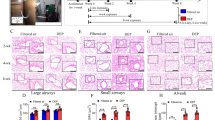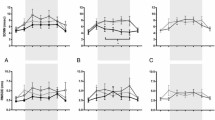Abstract
A growing body of evidence from epidemiological and toxicological studies provides a strong link between exposure to ambient particulate matter (PM) of varying size and increased cardiovascular and respiratory morbidity and mortality. This study was designed to evaluate the cardiopulmonary effects of ambient coarse, fine, and ultrafine particles collected in Chapel Hill, NC. Mice were exposed to each size fraction by oropharyngeal instillation. Twenty-four hours later, pulmonary inflammation was assessed by bronchoalveolar lavage and cardiac injury was measured using a Langendorff cardiac perfusion preparation. Recovery of post-ischemic left ventricular developed pressure and infarct size were measured as indeces of cardiac ischemia/reperfusion injury. Coronary flow rate was measured before, during, and after ischemia. We demonstrate that coarse PM caused the most significant pulmonary inflammatory responses. In contrast, hearts from ultrafine-exposed mice had significantly lower post-ischemic functional recovery and greater infarct size, while hearts from coarse and fine PM-exposed mice had no significant responses to ischemia/reperfusion. The coronary flow rate was significantly reduced in the ultrafine PM group. This study shows that exposure of mice to coarse PM results in significant pulmonary toxicity while ultrafine PM appears to enhance cardiac ischemia/reperfusion injury.





Similar content being viewed by others
References
Mills, N. L., Donaldson, K., Hadoke, P. W., Boon, N. A., MacNee, W., Cassee, F. R., et al. (2009). Adverse cardiovascular effects of air pollution. Nature Clinical Practice Cardiovascular Medicine, 6, 36–44.
Dockery, D. W. (2009). Health effects of particulate air pollution. Annals of Epidemiology, 19, 257–263.
Sun, Q., Wang, A., Jin, X., Natanzon, A., Duquaine, D., Brook, R. D., et al. (2005). Long-term air pollution exposure and acceleration of atherosclerosis and vascular inflammation in an animal model. JAMA, 294, 3003–3010.
Brook, R. D. (2008). Cardiovascular effects of air pollution. Clinical Science (London), 115, 175–187.
Simkhovich, B. Z., Kleinman, M. T., & Kloner, R. A. (2008). Air pollution and cardiovascular injury epidemiology, toxicology, and mechanisms. Journal of the American College of Cardiology, 52, 719–726.
Pope, C. A., I. I. I., Verrier, R. L., Lovett, E. G., Larson, A. C., Raizenne, M. E., Kanner, R. E., et al. (1999). Heart rate variability associated with particulate air pollution. American Heart Journal, 138, 890–899.
Gold, D. R., Litonjua, A. A., Zanobetti, A., Coull, B. A., Schwartz, J., MacCallum, G., et al. (2005). Air pollution and ST-segment depression in elderly subjects. Environmental Health Perspectives, 113, 883–887.
Mills, N. L., Tornqvist, H., Gonzalez, M. C., Vink, E., Robinson, S. D., Soderberg, S., et al. (2007). Ischemic and thrombotic effects of dilute diesel-exhaust inhalation in men with coronary heart disease. New England Journal of Medicine, 357, 1075–1082.
Wellenius, G. A., Coull, B. A., Godleski, J. J., Koutrakis, P., Okabe, K., Savage, S. T., et al. (2003). Inhalation of concentrated ambient air particles exacerbates myocardial ischemia in conscious dogs. Environmental Health Perspectives, 111, 402–408.
Cozzi, E., Hazarika, S., Stallings, H. W., I. I. I., Cascio, W. E., Devlin, R. B., Lust, R. M., et al. (2006). Ultrafine particulate matter exposure augments ischemia-reperfusion injury in mice. American Journal of Physiology Heart and Circulatory Physiology, 291, H894–H903.
Tong, H., McGee, J. K., Saxena, R. K., Kodavanti, U. P., Devlin, R. B., & Gilmour, M. I. (2009). Influence of acid functionalization on the cardiopulmonary toxicity of carbon nanotubes and carbon black particles in mice. Toxicology and Applied Pharmacology, 239, 224–232.
Simkhovich, B. Z., Marjoram, P., Kleinman, M. T., & Kloner, R. A. (2007). Direct and acute cardiotoxicity of ultrafine particles in young adult and old rat hearts. Basic Research in Cardiology, 102, 467–475.
Wold, L. E., Simkhovich, B. Z., Kleinman, M. T., Nordlie, M. A., Dow, J. S., Sioutas, C., et al. (2006). In vivo and in vitro models to test the hypothesis of particle-induced effects on cardiac function and arrhythmias. Cardiovascular Toxicology, 6, 69–78.
Bagate, K., Meiring, J. J., Gerlofs-Nijland, M. E., Cassee, F. R., Wiegand, H., Osornio-Vargas, A., et al. (2006). Ambient particulate matter affects cardiac recovery in a Langendorff ischemia model. Inhalation Toxicology, 18, 633–643.
Zanobetti, A., & Schwartz, J. (2009). The effect of fine and coarse particulate air pollution on mortality: A national analysis. Environmental Health Perspectives, 117, 898–903.
Langrish, J. P., Mills, N. L., & Newby, D. E. (2008). Air pollution: The new cardiovascular risk factor. Internal Medicine Journal, 38, 875–878.
Gilmour, M. I., McGee, J., Duvall, R. M., Dailey, L., Daniels, M., Boykin, E., et al. (2007). Comparative toxicity of size-fractionated airborne particulate matter obtained from different cities in the United States. Inhalation Toxicology, 19(Suppl 1), 7–16.
Phalen, R. F., & Mendez, L. B. (2009). Dosimetry considerations for animal aerosol inhalation studies. Biomarkers, 14(Suppl 1), 63–66.
Becker, S., Dailey, L. A., Soukup, J. M., Grambow, S. C., Devlin, R. B., & Huang, Y. C. (2005). Seasonal variations in air pollution particle-induced inflammatory mediator release and oxidative stress. Environmental Health Perspectives, 113, 1032–1038.
Nemmar, A., Vanbilloen, H., Hoylaerts, M. F., Hoet, P. H., Verbruggen, A., & Nemery, B. (2001). Passage of intratracheally instilled ultrafine particles from the lung into the systemic circulation in hamster. American Journal of Respiratory and Critical Care Medicine, 164, 1665–1668.
Dick, C. A., Singh, P., Daniels, M., Evansky, P., Becker, S., & Gilmour, M. I. (2003). Murine pulmonary inflammatory responses following instillation of size-fractionated ambient particulate matter. Journal of Toxicology and Environmental Health Part A, 66, 2193–2207.
Gordon, T. (2007). Linking health effects to PM components, size, and sources. Inhalation Toxicology, 19(Suppl 1), 3–6.
Samet, J. M., Graff, D., Berntsen, J., Ghio, A. J., Huang, Y. C., & Devlin, R. B. (2007). A comparison of studies on the effects of controlled exposure to fine, coarse and ultrafine ambient particulate matter from a single location. Inhalation Toxicology, 19(Suppl 1), 29–32.
Samet, J. M., Rappold, A., Graff, D., Cascio, W. E., Berntsen, J. H., Huang, Y. C., et al. (2009). Concentrated ambient ultrafine particle exposure induces cardiac changes in young healthy volunteers. American Journal of Respiratory and Critical Care Medicine, 179, 1034–1042.
Cho, S. H., Tong, H., McGee, J. K., Baldauf, R. W., Krantz, Q. T., & Gilmour, M. I. (2009). Comparative toxicity of size-fractionated airborne particulate matter collected at different distances from an urban highway. Environmental Health Perspectives, 117, 1682–1689.
Zhang, Q., Kusaka, Y., Sato, K., Nakakuki, K., Kohyama, N., & Donaldson, K. (1998). Differences in the extent of inflammation caused by intratracheal exposure to three ultrafine metals: Role of free radicals. Journal of Toxicology and Environmental Health Part A, 53, 423–438.
Brown, J. S., Zeman, K. L., & Bennett, W. D. (2002). Ultrafine particle deposition and clearance in the healthy and obstructed lung. American Journal of Respiratory and Critical Care Medicine, 166, 1240–1247.
Nemmar, A., Hoylaerts, M. F., Hoet, P. H., & Nemery, B. (2004). Possible mechanisms of the cardiovascular effects of inhaled particles: Systemic translocation and prothrombotic effects. Toxicology Letters, 149, 243–253.
Kodavanti, U. P., Schladweiler, M. C., Gilmour, P. S., Wallenborn, J. G., Mandavilli, B. S., Ledbetter, A. D., et al. (2008). The role of particulate matter-associated zinc in cardiac injury in rats. Environmental Health Perspectives, 116, 13–20.
Seagrave, J., McDonald, J. D., Bedrick, E., Edgerton, E. S., Gigliotti, A. P., Jansen, J. J., et al. (2006). Lung toxicity of ambient particulate matter from southeastern U.S. sites with different contributing sources: Relationships between composition and effects. Environmental Health Perspectives, 114, 1387–1393.
Wallenborn, J. G., Evansky, P., Shannahan, J. H., Vallanat, B., Ledbetter, A. D., Schladweiler, M. C., et al. (2008). Subchronic inhalation of zinc sulfate induces cardiac changes in healthy rats. Toxicology and Applied Pharmacology, 232, 69–77.
Urch, B., Silverman, F., Corey, P., Brook, J. R., Lukic, K. Z., Rajagopalan, S., et al. (2005). Acute blood pressure responses in healthy adults during controlled air pollution exposures. Environmental Health Perspectives, 113, 1052–1055.
Bagate, K., Meiring, J. J., Gerlofs-Nijland, M. E., Vincent, R., Cassee, F. R., & Borm, P. J. (2004). Vascular effects of ambient particulate matter instillation in spontaneous hypertensive rats. Toxicology and Applied Pharmacology, 197, 29–39.
Cozzi, E., Wingard, C. J., Cascio, W. E., Devlin, R. B., Miles, J. J., Bofferding, A. R., et al. (2007). Effect of ambient particulate matter exposure on hemostasis. Translational Research, 149, 324–332.
Wilson, D. W., Aung, H. H., Lame, M. W., Plummer, L., Pinkerton, K. E., Ham, W., et al. (2010). Exposure of mice to concentrated ambient particulate matter results in platelet and systemic cytokine activation. Inhalation Toxicology, 22, 267–276.
Dominici, F., Peng, R. D., Bell, M. L., Pham, L., McDermott, A., Zeger, S. L., et al. (2006). Fine particulate air pollution and hospital admission for cardiovascular and respiratory diseases. JAMA, 295, 1127–1134.
Mar, T. F., Koenig, J. Q., Jansen, K., Sullivan, J., Kaufman, J., Trenga, C. A., et al. (2005). Fine particulate air pollution and cardiorespiratory effects in the elderly. Epidemiology, 16, 681–687.
Acknowledgments
We thank Ms. Mary Daniels, Elizabeth Boykin, Judy Richards and Mr. Richard Jaskot for excellent technical assistance and Mr. James Lehmann for review of this manuscript. The authors declare that they have no competing financial interests.
Disclaimer
This paper has been reviewed by the National Health and Environmental Effects Research Laboratory, US Environmental Protection Agency, and approved for publication. The contents of this article should not be construed to represent Agency policy nor does mention of trade names or commercial products constitute endorsement or recommendation for use.
Author information
Authors and Affiliations
Corresponding author
Rights and permissions
About this article
Cite this article
Tong, H., Cheng, WY., Samet, J.M. et al. Differential Cardiopulmonary Effects of Size-Fractionated Ambient Particulate Matter in Mice. Cardiovasc Toxicol 10, 259–267 (2010). https://doi.org/10.1007/s12012-010-9082-y
Published:
Issue Date:
DOI: https://doi.org/10.1007/s12012-010-9082-y




